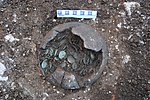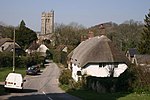Cerne Abbas
Sites of Special Scientific Interest in DorsetVillages in Dorset

Cerne Abbas () is a village and civil parish in the county of Dorset in southern England. It lies in the Dorset Council administrative area in the Cerne Valley in the Dorset Downs. The village lies just east of the A352 road 10 km (6.2 mi) north of Dorchester. Dorset County Council estimate that the population of the civil parish in 2013 was 820. In the 2011 census the population of the civil parish, combined with the small neighbouring parish of Up Cerne, was 784. In 2008 it was voted Britain's "Most Desirable Village" by estate agent Savills. It is the location of the Cerne Abbas Giant, a chalk figure of a giant naked man on a hillside.
Excerpt from the Wikipedia article Cerne Abbas (License: CC BY-SA 3.0, Authors, Images).Cerne Abbas
Acreman Street,
Geographical coordinates (GPS) Address Nearby Places Show on map
Geographical coordinates (GPS)
| Latitude | Longitude |
|---|---|
| N 50.8095 ° | E -2.481 ° |
Address
Acreman Street
Acreman Street
DT2 7JX , Cerne Abbas
England, United Kingdom
Open on Google Maps










